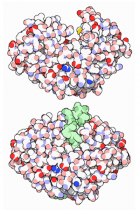Abstract
Research Article
Acute pneumonia: Facts and realities against etiological hypotheses and beliefs
Klepikov Igor*
Published: 04 February, 2019 | Volume 4 - Issue 1 | Pages: 010-017
Modern AP concepts are focused exclusively on the infectious nature of the disease and the presence of certain pathogens. This belief determines the principles of treatment, the lack of effectiveness of which remains a concern of health professionals. The article presents a fragment of the study devoted to the etiology of АP. 994 children aged 4 months to 14 years with various forms of so-called community-acquired pneumonia were examined and treated. Bacteriological examination of the material from the inflammation zone was carried out in 542 patients. Experiments on modeling АP and its pleural complications were performed on 44 animals. The obtained results and critical analysis of the literature data and scientific facts allow us to consider bacteria only as one of the etiological elements of АP, which is not mandatory in all cases of the disease. Scientifically based revision of existing ideas about the causes and mechanisms of AP development leads to the need for a radical change in the principles of treatment and is a strategic direction in solving the problem.
Read Full Article HTML DOI: 10.29328/journal.jcicm.1001019 Cite this Article Read Full Article PDF
Keywords:
Acute pneumonia; Etiology; Microflora; Symbionts; Experimental model of acute pneumonia; Pleural empyema; New doctrine
References
- Ruuskanen O, Lahti E, Jennings LC, Murdoch DR. Viral pneumonia. Lancet. 2011; 377 (9773): 1264–1275. Ref.: https://goo.gl/tSjiXj
- Singh V, Aneja S. Pneumonia - management in the developing world. Paediatric Respiratory Reviews. 2011; 12: 52–59. Ref.: https://goo.gl/AsLKEr
- Weiss AJ, Wier LM, Stocks C, Blanchard J.Overview of Emergency Department Visits in the United States, 2011. HCUP Statistical Brief #174. 2006; Ref.: https://goo.gl/pUC3HB
- Lim WS, Baudouin SV, George RC, Hill AT, Jamieson C, et al. BTS guidelines for the management of community acquired pneumonia in adults: update 2009. Thorax. 2009; 64 (Suppl 3): iii1–55. Ref.: https://goo.gl/2rrbTf
- Lodha R, Kabra SK, Pandey RM. Antibiotics for community-acquired pneumonia in children. Cochrane Database Syst Rev. 2013; 6: CD004874. Ref.: https://goo.gl/BFs6j5
- : https://goo.gl/mNbU4t
- Nair GB, Niederman MS. Community-acquired pneumonia: an unfinished battle. Med Clin North Am. 2011; 95: 1143–1161. Ref.: https://goo.gl/tVSySy
- Elemraid MA, Thomas MF, Blain AP, Rushton SP, Spencer DA, et al. Risk factors for the development of pleural empyema in children. Pediatr Pulmonol. 2015; 50: 721–726. Ref.: https://goo.gl/HEVcVL
- Klepikov I, Rikov V. A method for modeling parapneumonic pleurisy. Author’s certificate for invention. 1990; SU, No 1631574. A1.
- Klepikov I. Acute pneumonia and its purulent and destructive complications in children in the midst of a major industrial centre of Western Siberia. Dissertation for the degree of doctor of medical science. Leningrad. 1989;
- : https://goo.gl/wBGPyZ
- Jain S, Williams D, Arnold SR, Ampofo K, Bramley AM, et al. Community-Acquired Pneumonia Requiring Hospitalization among US Children. N Engl J Med. 2015; 372: 835-845. Ref.: https://goo.gl/4pqP83
- Mani CS, Murray DL. Acute Pneumonia and Its Complications. Part II: Clinical Syndromes and Cardinal Features of Infectious Diseases: Approach to Diagnosis and Initial Management. SECTION D: Lower Respiratory Tract Infections. In the book: SS Long, LK Pickering, CG Prober. Principles and Practice of pediatric infectious diseases. Edinburgh, New York: Elsevier Churchill Livingstone. 2012; 235-245.
- Davis CP. Normal Flora. In: Baron S, editor. Medical Microbiology. 4th edition. Galveston (TX): University of Texas Medical Branch at Galveston; 1996. Chapter 6. Ref.: https://goo.gl/mhkfCX
- : https://goo.gl/6LA35S
- Li ST, Tancredi DJ. Empyema Hospitalizations Increased in US Children Despite Pneumococcal Conjugate Vaccine. Pediatrics. 2010: 125: 26-33. Ref.: https://goo.gl/aPX2JW
- Strachan RE, Snelling TL, Jaffé A Increased paediatric hospitalizations for empyema in Australia after introduction of the 7-valent pneumococcal conjugate vaccine. Bull World Health Organ. 2013; 91: 167-173. Ref.: https://goo.gl/MXTYqQ
- Prina E, Ranzani OT, Torres A. Community-acquired pneumonia. Lancet. 2015; 386 (9998): 1097-108. Ref.: https://goo.gl/hQgEjR
- Igor Klepikov. Acute pneumonia: a new look at the old problem. Lambert Academic Publishing. 2017; ISBN (978-3- 330-35250-6). Ref.: https://goo.gl/9G1UHA
Similar Articles
-
Knowledge, attitude and practices associated with diagnosis and management of Skin and Soft Tissue Infections (SSTIs) among Pediatric Residents and Physicians in a Tertiary Hospital in United Arab Emirates (UAE)Eiman Al Blooshi,Farah Othman,Abeer Al Naqbi,Majid Al Rumaithi,Khawla Fikry,Mariam Al Jneibi,Hossam Al Tatari*. Knowledge, attitude and practices associated with diagnosis and management of Skin and Soft Tissue Infections (SSTIs) among Pediatric Residents and Physicians in a Tertiary Hospital in United Arab Emirates (UAE) . . 2017 doi: 10.29328/journal.jcicm.1001007; 2: 034-039
-
Evaluation of Desmin, α-SMA and hTERT expression in pulmonary fibrosis and lung cancerFarahnaz Fallahian*,Seyed Ali Javad Moosavi,Frouzandeh Mahjoubi,Samira Shabani,Pegah Babaheidarian,Tayebeh Majidzadeh. Evaluation of Desmin, α-SMA and hTERT expression in pulmonary fibrosis and lung cancer. . 2018 doi: 10.29328/journal.jcicm.1001011; 3: 001-009
-
Dependence of the results of treatment of acute pneumonia on the doctrine of the diseaseIgor Klepikov*. Dependence of the results of treatment of acute pneumonia on the doctrine of the disease. . 2018 doi: 10.29328/journal.jcicm.1001012; 3: 010-012
-
Acute pneumonia: Facts and realities against etiological hypotheses and beliefsKlepikov Igor*. Acute pneumonia: Facts and realities against etiological hypotheses and beliefs. . 2019 doi: 10.29328/journal.jcicm.1001019; 4: 010-017
-
Angioarchitectonics of acute pneumoniaKlepikov Igor*. Angioarchitectonics of acute pneumonia. . 2019 doi: 10.29328/journal.jcicm.1001020; 4: 018-022
-
Do you really want to improve the results of treatment for acute pneumonia?Klepikov Igor*. Do you really want to improve the results of treatment for acute pneumonia?. . 2019 doi: 10.29328/journal.jcicm.1001021; 4: 023-027
-
Clinical profile, etiology, outcome and new-onset diabetes: A SARI case seriesSiddharth Agarwal*,Sapna Agarwal,Raj Kumar Verma,Shreyash Dayal. Clinical profile, etiology, outcome and new-onset diabetes: A SARI case series. . 2022 doi: 10.29328/journal.jcicm.1001041; 7: 005-015
-
Why is Pain not Characteristic of Inflammation of the Lung Tissue?Igor Klepikov*. Why is Pain not Characteristic of Inflammation of the Lung Tissue?. . 2024 doi: 10.29328/journal.jcicm.1001046; 9: 005-007
-
Justification of the Principles of Emergency Care for Acute PneumoniaIgor Klepikov*. Justification of the Principles of Emergency Care for Acute Pneumonia. . 2025 doi: 10.29328/journal.jcicm.1001051; 10: 001-000
Recently Viewed
-
Potter Syndrome: A case studyAnestakis D*,Konstantinidou,Nikolaou A,Moumou G,Karakasi MV,Pavlidis P,Chatzifotiou E. Potter Syndrome: A case study. J Forensic Sci Res. 2017: doi: 10.29328/journal.jfsr.1001007; 1: 063-067
-
The Effect of Cement and wrapping on the Decomposition rate of the Rabbit CarcassesLai Poh Soon*,Khoo Lay See,Nazni Wasi Ahmad,Azlina Zulkapli,Nurul Kharmila Abdullah,Mohd Shah Mahmood,Ahmad Hafizam Hasmi. The Effect of Cement and wrapping on the Decomposition rate of the Rabbit Carcasses. J Forensic Sci Res. 2017: doi: 10.29328/journal.jfsr.1001006; 1: 046-062
-
Alternatives to Apical View in Predicting Fluid Responsiveness by Transthoracic Echocardiography: An Observational StudyHaimeur Yassine*,Aberouch Larbi,Tadili Jawad,Faroudy Mamoun,El Kettani Ali. Alternatives to Apical View in Predicting Fluid Responsiveness by Transthoracic Echocardiography: An Observational Study. J Clin Intensive Care Med. 2025: doi: 10.29328/journal.jcicm.1001052; 10: 006-012
-
Cerebral Autoregulation-Directed Therapy in Adults with Non-Traumatic Brain Injury in Neuro-Critical Care: A Scoping ReviewYassine Haimeur*,Mouhssine Doumiri,Mourad Amor. Cerebral Autoregulation-Directed Therapy in Adults with Non-Traumatic Brain Injury in Neuro-Critical Care: A Scoping Review. J Clin Intensive Care Med. 2025: doi: 10.29328/journal.jcicm.1001053; 10: 013-022
-
Prolonged Latency in Previable PPROM in Twin Pregnancies: A Case SeriesNeha Sahay*, Atia Aziz, SD Poddar and Suneeta Singh. Prolonged Latency in Previable PPROM in Twin Pregnancies: A Case Series. Clin J Obstet Gynecol. 2024: doi: 10.29328/journal.cjog.1001174; 7: 107-111
Most Viewed
-
Sinonasal Myxoma Extending into the Orbit in a 4-Year Old: A Case PresentationJulian A Purrinos*, Ramzi Younis. Sinonasal Myxoma Extending into the Orbit in a 4-Year Old: A Case Presentation. Arch Case Rep. 2024 doi: 10.29328/journal.acr.1001099; 8: 075-077
-
Evaluation of Biostimulants Based on Recovered Protein Hydrolysates from Animal By-products as Plant Growth EnhancersH Pérez-Aguilar*, M Lacruz-Asaro, F Arán-Ais. Evaluation of Biostimulants Based on Recovered Protein Hydrolysates from Animal By-products as Plant Growth Enhancers. J Plant Sci Phytopathol. 2023 doi: 10.29328/journal.jpsp.1001104; 7: 042-047
-
Feasibility study of magnetic sensing for detecting single-neuron action potentialsDenis Tonini,Kai Wu,Renata Saha,Jian-Ping Wang*. Feasibility study of magnetic sensing for detecting single-neuron action potentials. Ann Biomed Sci Eng. 2022 doi: 10.29328/journal.abse.1001018; 6: 019-029
-
Physical activity can change the physiological and psychological circumstances during COVID-19 pandemic: A narrative reviewKhashayar Maroufi*. Physical activity can change the physiological and psychological circumstances during COVID-19 pandemic: A narrative review. J Sports Med Ther. 2021 doi: 10.29328/journal.jsmt.1001051; 6: 001-007
-
Pediatric Dysgerminoma: Unveiling a Rare Ovarian TumorFaten Limaiem*, Khalil Saffar, Ahmed Halouani. Pediatric Dysgerminoma: Unveiling a Rare Ovarian Tumor. Arch Case Rep. 2024 doi: 10.29328/journal.acr.1001087; 8: 010-013

HSPI: We're glad you're here. Please click "create a new Query" if you are a new visitor to our website and need further information from us.
If you are already a member of our network and need to keep track of any developments regarding a question you have already submitted, click "take me to my Query."
















































































































































